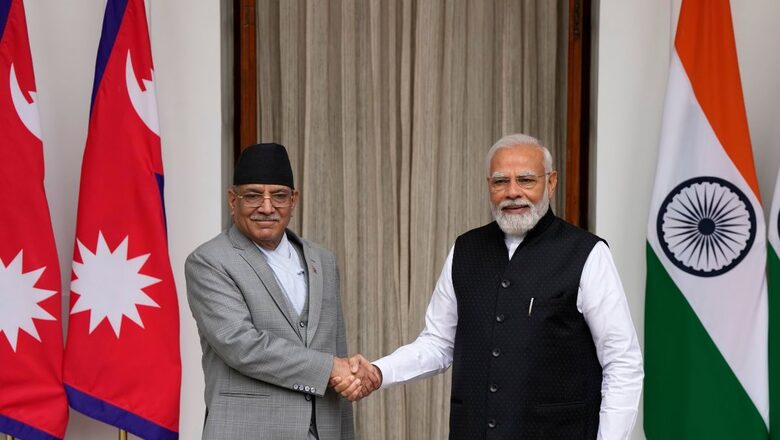
views
Chinese Ambassador to Nepal Chen Song recently unleashed a tirade against India. While addressing a gathering on September 2, at an event in Kathmandu (Nepal), his aggressive comments caught the audience by surprise as they appeared to be out of context. These remarks should be seen in the context of the forthcoming visit of Nepal’s Prime Minister to China in the fourth week of September.
Chen Song tried to establish that Indian foreign policy is not conducive to Nepal and that the Indo-Nepali trade relations are loaded against Kathmandu. He projected China as the only viable alternative for Nepal’s better future.
This is a classic Chinese ploy to have a dominant influence over India’s traditional partners in this part of the world. It did the same with Sri Lanka and the results are quite visible as the world witnessed the economic collapse of Sri Lanka and political chaos. This was the result of the growing Chinese influence in Sri Lanka. Now, it is targeting Nepal.
Let us analyse Song’s statements or claims in the context of available data, facts and figures.
Claim No. 1: Indian policies are not conducive to its neighbour and specifically to Nepal.
Fact: This statement comes from the diplomat of a country that has boundary disputes with at least 17 countries including Nepal. China’s disdain for international laws is well-known and documented. The Chinese continue to make false claims on territories. These claims are generally based on distorted historical records. A glaring example of the same is the UNCLOS 2016 Arbitral Award that refuted Chinese claims on the South China Sea. The United States which had supported Communist China’s economic expansion for the last four decades is now revisiting its ties with it. Most of the European countries now see China as a threat to global peace and order and a large number of African and Latin American countries are trying to resist the Chinese plunder of their natural resources.
The Chinese hegemony in the entire Indo-Pacific region is not hidden from anyone. The perils of dealing with China are evident. The Chinese debt trap viciously pushes various emerging and underdeveloped economies to crash and ultimately compromise their sovereignty. Taking a cue from what happened with Pakistan and Sri Lanka, other South Asian countries like Nepal and Bangladesh are exercising necessary caution while dealing with any Chinese trade prepositions under the Belt and Road Initiative(BRI) or bilateral agreements.
Claim No. 2: Nepal last year exported electricity worth $10 billion to India and imported worth $19 billion. Song cited these figures to highlight the glaring trade deficit between India and Nepal and portrayed it in a negative manner.
Fact: To better understand the issue one has to understand the geography of Nepal.
- Why is Nepal facing a power deficit trade despite its higher potential?
The Kathmandu Post discussed this in an article titled “Hydropower and South Asian Integration”. The article mentioned that Nepal’s hydropower potential ranks among the highest globally in terms of per capita and unit of GDP. The installed capacity of hydropower production in Nepal has increased from 1050 MW in 2012 to 2700 MW in 2023. This will increase to 9000 MW in the next 10 years as 235 hydropower plants are still under construction. With Nepal’s national peak demand of 1700 MW surplus energy of around 900 MW could be exported.
The reason for the power deficit equation lies in the design of the hydroelectric projects. Most of these projects are ‘run-of-the-river’ type i.e. they don’t have reservoirs and thus rely on seasonal flow of rivers. So, while in summers/wet seasons, Nepal has been able to export electricity, during winters, Nepal finds it difficult to meet its domestic requirements.
The reason why Nepal has resorted to a ‘run-of-the-river’ design is because constructing reservoirs needs large investments. It also requires larger space and hence, will require displacing the population from the adjacent areas. Given the past record of violent protests on such issues, authorities in Nepal have been reluctant to do something that could cause a major political flare-up.
Chen Song failed to highlight the fact that the Indian purchase of Nepal’s power is helping the latter to reduce the power import bill to almost half. In case India had not bought electricity, Nepal would have faced a major challenge to meet the enormous expenditure to meet its power requirement.
Given Nepal’s geography and India’s rising per capita electricity consumption (Per Capita Consumption, Nepal: 325 KwH; India: 1,255 KwH), India is the natural ally and trade partner that can buy surplus Nepalese energy further supporting the Nepalese economy. On the other hand, the geography to the north of Nepal is not conducive enough to lay out transmission lines to Tibet so even if China opts to buy the Nepalese electricity (though that seems a remote possibility as Tibet doesn’t require additional electricity due to sparse civil population along the border and lack of industries), the mountainous geography will put a cap on how much of power could be feasibly exported.
In fact, Nepal has been negotiating with China since 2018 to develop the Kerung Rasuwagadhi-Galchhi-Ratmate cross-border 400 KV Transmission line (located West of Kathmandu) but, there has been no progress on the project. On the other hand, laying transmission lines to India is very easy as these lines would traverse largely plains, also known commonly as the Terai region.
On September 5 this year, the Modi government granted approval to purchase an additional 10,000 MW of electricity from Nepal to meet its target of Green Energy.
Claim No. 3: Nepalese imports of cereals and agricultural products from India is not conducive to the Nepalese economy and Nepal should emulate the Chinese model.
Fact: Nepal is a mountainous country hence; large tracts of fertile agricultural land are not available. This restricts its agricultural production resulting in an unavoidable trade deficit in agricultural products. However, to minimise this deficit, India has become the largest importer of Nepalese agricultural products.
The cost of imports for Nepal is much lower when it comes to importing from India. The Chinese imports would cost much more, further burdening the Nepalese economy.
What Chinese diplomats hide from the common Nepalese is that while Nepal has been getting unabated access to cheaper air corridor, ports and road connectivity through India, China has kept all the crossing/trading points with Nepal closed since the advent of Covid-19. It opened up Tatopani Crossing in August 2023 but the operations at all the trading points continue to be very unreliable as the Chinese government has been shutting down these points through unilateral decisions without consulting the Nepalese government.
In April 2022, China had agreed to provide duty-free treatment to goods of Nepali origin covering 98 per cent tariff lines, interestingly China had also barred any import from Nepal for over two years citing Covid restrictions. In fact, the China-Nepal trade data shows that the bulk of the items listed under the agreement are hardly bought by China from Nepal. On the other hand, India remains the largest importer (more than 61 per cent of Nepal’s exports) of Nepalese goods.
Claim No. 4: Chen Song called Nepal to emulate the Chinese Social Structure to build a sound base for economic prosperity.
Fact: The claim came from a diplomat of the country known for suppression of human rights, crushing religious and cultural freedom in many of its provinces, especially in Xinjiang and Tibet. The vast network of surveillance and censorship being carried out by the Chinese Communist Party (CCP), across China, is well-known to the whole world. The suppression of dissent in Hong Kong and crackdown on overseas activists of Chinese, Tibetan and Uighur origins is part of its State Policy.
Conclusion
China has been trying to create a wedge between India and Nepal. The Chinese deep state has been manipulating the narrative in Nepal in this context. Chinese diplomats have indulged openly in anti-India activities in Nepal. However, the common masses of Nepal are wary of Chinese imperialist designs. That is why the Nepalese authorities are also treading with caution. This is bound to frustrate China. The outburst of Chinese diplomats against India should be seen in this context also. However, one shouldn’t estimate the Chinese influence in the Nepalese political establishment. So, India needs to watch the situation in Nepal more closely than ever.
The writer, an author and columnist has written several books. He tweets @ArunAnandLive. Views expressed in the above piece are personal and solely that of the author. They do not necessarily reflect News18’s views.


















Comments
0 comment